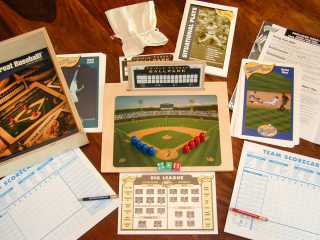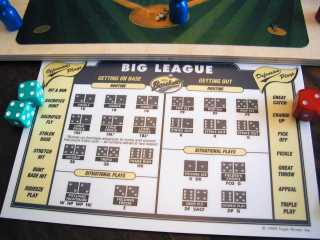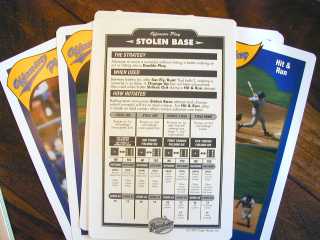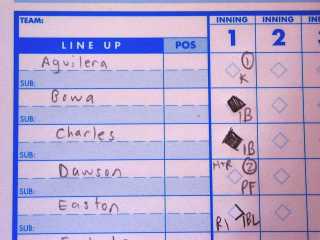Baseball Hall of Fame site
Major League Baseball site
Black Baseball historical site

|
| An overview of all the great components you get. |
However, a greater passion of mine was playing the game. Unfortunately I never played on a Little League or school team, but I did spend countless hours at the school yard playing all kinds of baseball games usually for two or four players with bats and mits and a strike zone painted on the brick wall. One game was Singles and Homers where each side has one or two players. The pitcher pitched a hard rubber ball at the strike zone, obviously horse hide would disintegrate with repeated fast balls against a brick wall, and balls and strikes were counted normally. The batter would swat away and try to score some hits. Any grounder that could not be fielded was a single: any grounder that could be fielded was an out. Similarly fly balls were singles or outs, but a mighty slam over the outfielder's head was a home run!
Some friends and I played this game repeatedly during the hot summer school vacations. Not just double headers, but 5 or 6 games at a stretch. Then it was time to get a giant Super Gulp at the Seven-Eleven and head home. To this day I am pretty good in the batting cages as a result of swatting fast balls.
Why do I preface this game review with this history? Obviously if you are a baseball fan you know why. Once baseball is in your blood it stays with you, and you are always fond of it. Talk to any baseball fan, and they will have similar memories from long ago of playground games and going to games. Go to the Triple Threat Baseball site, and you can read a similar story and see Little League pictures of the game designers. Baseball fans have a unique love for the game and warm fuzzy memories that go back to childhood.

|
| This Dice Card determines what play you roll. |
Baseball has a rhythm and a tension that simply does not exist in other games. It has an excitement that comes not so much from action - baseball is fraught with pauses and gaps and only occasional outbursts of action. No, for me the excitement of baseball come from a long gradual build-up of tension. It comes from a one run game when the tying run gets on first. The tension builds when the runner gets to third. And then there are two outs. And you're dying to know if that runner will get home. And then the batter goes to 3 balls and 2 strikes, and the tension is unbearable. And on the final pitch the batter knocks the ball out of the park!
Triple Threat Baseball does a good job of modeling the feel, the rhythms, and the pace of baseball. First let me explain how the game works. In general, it is a dice rolling game. The batting player rolls 2 six sided dice and consults the "Dice Throw Card" (shown up close in the first picture on the right) to see which action occurs: hit, error, strike out, ground out, etc. The rolls are distributed to mimic the distribution of occurances in real baseball. Of course, a six - six roll is a home run! Statistically, I don't think this mimics real baseball, but it sure is easy to remember that box cars are a home run.
On certain rolls, players consult the "Situational Play Book" to see what happens. For instance, a double play becomes a ground out with no runners. With two runners and no outs, the batter is out, but another die is rolled to determine whether the lead or following runner is out. And thus goes the entire game. Roll, look up, roll some more. After 3 outs, change sides and change rollers.

|
| Here are the offensive plays you can call |
However, seasoned gamers will want to play the "Big League" version of the game. The "Big League" game uses an enhanced Dice Throw card and Situational Play book to add more decision making. Additionally, each team gets 7 offensive and 7 defensive plays to call during the game. The Offensive Cards are shown in the second picture on the left. These interrupt the flow of play, but they interject more managerial decision making as in real baseball. For instance, with a runner on first, and no outs, you might decide to use the "Hit and Run" play to advance the runner more bases. Similarly, you might want to call a "Stolen Base" to move the player forward. For defensive managers, there are "Pick Off" attempts and "Change Up" plays to try to befuddle the batter. These plays are nicely summarized on big Play Cards that explain the rolls required. At first it is troublesome remembering all the rolls and all the plays, and one spends a lot of time carefully reading the cards, but after a few games the plays become second nature, and it is easy to blast through the calls. Since the special play calls are limited in number, the most important aspect of the game is managing the perfect time to call the plays. Just as in real baseball, you cannot call for a steal every play, or else it will telegraph itself to the opponents. Here you are limited in the special plays you can make.
What Triple Threat Baseball does best is establish the feel of the game. The rules book is littered with the terms and the lore of baseball. There are pages devoted to explaining rules and terms of the game. It includes such statements as "Agree to use good manners. Baseball is a game of order and taking turns." It also recommends that you "Sing the National Anthem," and announce "Play Ball!" to start the game. Triple Threat Baseball is not so much about real players, but creating a fantasy imitation of the real game.
Much of the rulebook is dedicated to baseball stat-keeping, and the game provides a thick pad of Game Scorecards to use with the game or at any real baseball game. You can see an example of this cryptic record keeping system in the picture on the right below. If you have never done baseball score keeping, the rule book shows you how to do it easily. I've grown up scoring games, and the system in Triple Threat Baseball is the same thing I've used. Experienced fans will find this very easy to do.

|
| An overview of all the great components you get. |
How does Triple Threat Baseball stand up to other baseball games? When I was younger, I played Sports Illustrated All Time All Star baseball. That was a game based on the statistics of real players. Avalon Hill's Statis Pro baseball also uses real stats but with current players. You make your lineup with baseballs greats, and then you roll dice to see the outcome. Both of those games are more accurate statistically than Triple Threat Baseball, and they also offer differentiated players which is nice. However, those games can become dated when new players arrive and you don't have cards for them. It also is somewhat strange repeatedly playing with the 1979 statistics again and again. In Triple Threat Baseball, every batter is the same, but it makes up nicely for this simplification with the addition of the offensive and defensive plays. Triple Threat Baseball certainly has the edge in terms of the quality of components and the game feel.
Who will like Triple Threat Baseball?
Obviously it appeals to baseball fans.
For fans, baseball and all of its decision making is sublime, and this game
nicely models that.
Hard core board gamers probably will dislike the game because of the limited
actions and the stereotypical play.
Hard core gamers will also dislike the fact that all the batters are alike.
However, Triple Threat Baseball is more about recreating the
lazy afternoon feel of baseball, the build up of tension,
and the excitement of a home run.
If you like baseball, and want to experience this feeling in a game, I would say
this game is for you.